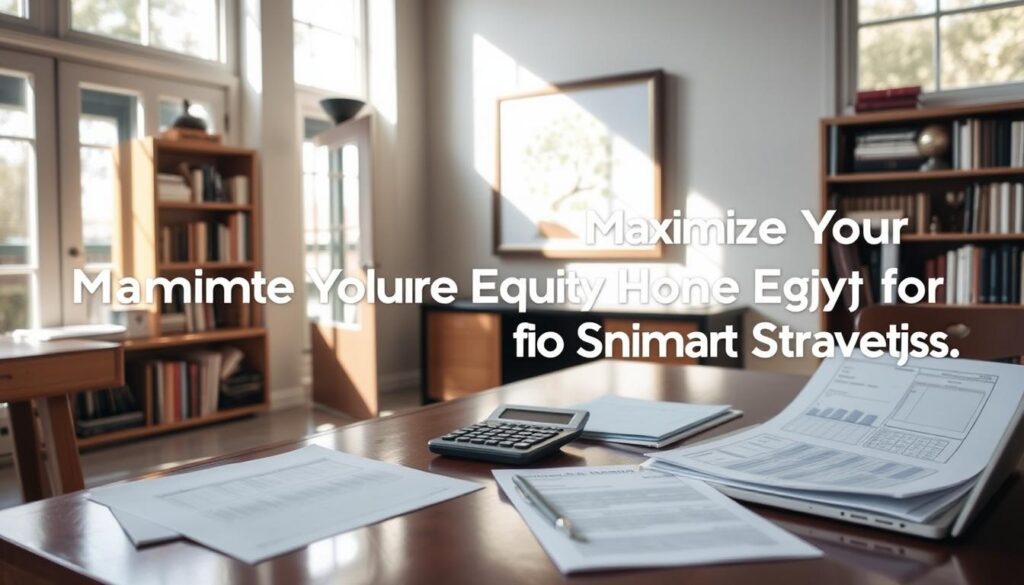Did you know that 85% of U.S. homeowners leave behind over $100,000 in untapped home equity? Chartway and HomeLight reveal this overlooked resource could fund renovations, payoff debt, or fuel future goals. Your home equity isn’t just a number—it’s a flexible tool for growth through loans or HELOCs.
Smart home equity investments can boost property value and financial stability. This guide uses expert insights to show safe, actionable steps. Let’s unlock your home’s potential today.
Getting Started with Home Equity Investments
Your home isn’t just a place to live—it’s a financial asset. Equity investments in real estate can transform your property into a tool for long-term growth. Understanding how this works is the first step toward unlocking its potential.
Why Home Equity Investments Matter
Equity investments grow as you pay down your mortgage. Each payment reduces debt while increasing your ownership share. Property value appreciation and smart home improvements also boost your equity. This growth creates flexibility: funds for education, business ventures, or retirement.
- Mortgage reduction directly increases your stake in the property.
- Rising market values can add thousands to your net worth quietly.
- Renovations like kitchen upgrades often return 80-100% of costs in resale value.
Assessing Your Current Home Financials
Start by calculating your current equity. Subtract your remaining loan balance from your home’s appraised value. For example, a $300k home with a $150k mortgage has $150k equity. Track these numbers yearly to see progress.
Financial advisors recommend reviewing three factors:
- Current mortgage balance (check your latest statement)
- Recent property appraisal (contact local real estate agents)
- Home improvement costs (keep receipts for documentation)
Building equity investments wisely starts with clear awareness of these figures. Small steps today lay the foundation for bigger opportunities tomorrow.
Navigating the Home Equity Landscape
Choosing the right equity strategy starts with knowing your options. HELOC benefits like adjustable access and competitive rates position them as a top tool for financial flexibility. Over 40% of homeowners now use these options, per HomeLight and CoreLogic, adapting to market shifts while preserving long-term stability.
- Home equity loans offer fixed lump sums for defined goals.
- HELOCs provide revolving credit for ongoing needs.
- Selling remains an option for major financial transitions.
HELOC benefits shine in their adaptability. Unlike fixed loans, these lines let you borrow, repay, and reuse funds as your needs change. Interest rates often stay lower than credit cards, making them ideal for renovations or unexpected costs. Experts stress using these lines strategically to avoid over-reliance.
Smart moves to stay on track include:
- Lower your mortgage balance to unlock more accessible equity.
- Pick upgrades that boost resale value, like updated kitchens or bathrooms.
- Monitor local market trends to time borrowing and selling decisions.
For foundational knowledge on equity growth, review AcademyBank’s overview. Balancing these steps helps you align choices with your financial goals.
Understanding Home Equity Investments
Your home’s equity is the portion of your property you truly own. It grows as you pay down your mortgage and improve your home. Let’s break down how this works.
Exploring the Key Concepts
Every mortgage payment chips away at your loan’s principal balance. The part of your payment that goes toward principal directly boosts your equity. Interest, meanwhile, funds the lender. Over time, your equity grows as principal increases. Think of it like saving money in a bank account tied to your home.
How Equity Builds Over Time
Equity rises through three main paths:
- Mortgage payments: Chartway reports that 30% of homeowners see equity gains from paying down loans over 5+ years.
- Home improvements: Renovations like kitchen upgrades (common in home renovation finance plans) add value. HomeLight data shows kitchens can recoup 70% of costs at resale.
- Market trends: Rising housing prices in strong markets can boost equity without you spending a dime.
Regular home renovation finance choices matter. Small upgrades—like energy-efficient windows—can make your home more appealing to buyers while building long-term value. Track these factors to see your equity grow year after year.
Identifying Your Home’s Potential
Your home’s equity isn’t just a number on a balance sheet—it’s a gateway to smarter financial decisions. Start by calculating your current equity: subtract your remaining mortgage balance from your home’s market value. This figure determines how much you can potentially leverage for opportunities like debt consolidation or home improvements.
- Check recent appraisals or neighborhood sales to estimate market value
- Review your mortgage statement for principal paid-to-date
- Calculate equity = Current Market Value – Remaining Mortgage Balance
Chartway’s data shows homeowners with $50k+ equity can save thousands by refinancing high-interest debts. Debt consolidation loans backed by home equity often offer lower rates than credit cards, letting you simplify payments and reduce interest costs. But proceed strategically: assess your long-term goals and cash flow needs before tapping into this resource.
Consider these next steps:
- Consult a financial advisor to model different scenarios
- Compare loan terms using online equity calculators
- Review local market trends affecting home values
Every dollar of equity represents choices—whether paying off debt, funding upgrades, or building long-term wealth. Make sure your strategy aligns with both immediate needs and future aspirations.
Evaluating Investment Options
When exploring real estate investing opportunities tied to your home equity, comparing options is key. Traditional loans and modern alternatives each offer distinct paths. Let data guide your choice: HomeLight reports that 68% of homeowners prefer flexible options like HELOCs over fixed loans. Start by weighing your priorities.
Traditional vs. Alternative Strategies
- Home Equity Loans: Offer fixed rates and set repayment terms—ideal for predictable budgets.
- HELOCs (Home Equity Lines of Credit): Provide revolving access to funds, great for fluctuating needs like renovations.
- Cash-Out Refinances: Replace your existing mortgage for immediate cash, but may extend repayment timelines.
Risk Considerations
Mortgage advisors stress three critical factors: interest rates, fees, and long-term commitments. For example, HELOCs might have variable rates tied to the prime rate, while cash-out refinances often involve closing costs. Always calculate total costs versus potential returns. Successful investors prioritize aligning strategies with their risk tolerance and financial goals.
Maximizing Your Returns
Smart strategies turn home equity into growth opportunities. Focus on actions that directly impact your property value and long-term gains.
Optimization Techniques for Home Equity
Data from CoreLogic shows that strategic upgrades add 10-15% equity potential. Prioritize high-impact changes like modern kitchens or energy-efficient systems. For example, solar panels can increase resale value by $15,000+, per 2023 studies.

- Curated renovations: Target features buyers prioritize—like master suites or smart home tech.
- Landscaping upgrades: Well-maintained yards boost curb appeal and value by up to 8%.
Leveraging Market Trends
Track regional trends using HomeLight reports to time investments. Neighborhoods with strong job growth or school districts often see faster property value appreciation. Monitor local housing inventory levels—low supply can mean higher equity gains.
Use these steps to align with market shifts:
- Research Zillow’s neighborhood price forecasts.
- Compare year-over-year trends in your area.
- Adjust improvement timelines to match peak buying seasons.
Combining data-driven decisions with targeted upgrades positions you to capitalize on growth opportunities effectively.
Managing Risk and Reward in Your Investments
Managing risk while pursuing home equity gains starts with smart mortgage strategies. Financial advisors emphasize balancing debt levels against your equity growth. Over-leveraging can strain budgets, but thoughtful planning keeps your investments on track.
Balancing Debt and Equity
- Monitor debt-to-income ratios: Keep monthly payments below 28% of income to avoid overextension.
- Re-evaluate interest rates: Shop for lower-rate mortgages or refinance options to free up cash flow.
- Set equity benchmarks: Track how much equity you’re building annually to align with long-term goals.
Contingency Planning
Market shifts or job changes demand preparedness. Mortgage strategies should include:
- Emergency funds: Save 3-6 months of expenses to cover unexpected costs.
- Insurance reviews: Ensure homeowners policies cover property value increases and liability risks.
- Regular financial checkups: Schedule annual reviews with a certified financial planner to adjust plans as life circumstances change.
Experts at the National Association of Realtors recommend staying flexible. When markets dip, having a contingency fund protects against sudden drops in property appraisals. Proactive steps like these turn potential risks into manageable challenges, ensuring your investments stay aligned with your financial health.
Financing Your Investment Journey
Choosing the right financing method is key to unlocking your home’s potential. Let’s explore investment options tailored to your financial goals, using insights from experts at HomeLight and Chartway.
- HELOCs (Home Equity Lines of Credit): Offer flexible access to funds as you need them. Ideal for projects with unpredictable costs.
- Home Equity Loans: Provide a lump sum upfront. Best for fixed-cost renovations or debt consolidation.
- Cash-Out Refinances: Replace your existing mortgage with a larger loan. Great for major overhauls or large-scale investments.
Compare these investment options using this guide:
| Product | Pros | Cons | Best For |
|---|---|---|---|
| HELOC | Flexible withdrawals | Variable interest rates | Small, phased projects |
| Home Equity Loan | Fixed monthly payments | Requires collateral | Large home improvements |
| Cash-Out Refinance | Larger funds available | Potential longer repayment terms | Major renovations or debt consolidation |
Consult with lenders like Chartway to align your investment options with your cash flow and long-term plans. Remember: every decision should support your home’s future value.
Real-World Success Stories
Discover how real homeowners turned home equity into opportunities. Stories like Ericka and Pat’s show how smart risk management and tailored loans can transform finances. Explore their journey here: New American Funding’s case studies.
Case Studies from Fellow Homeowners
Ericka and Pat used FHA loans to secure their home and later refinanced with FHA streamline options. Their risk management approach kept costs manageable while building equity. Over a decade, their home value grew, unlocking funds for future investments.
Key Lessons Learned
| Lesson | Example | Takeaway |
|---|---|---|
| Effective risk management | FHA programs reduced payment strain | Government-backed loans lower financial stress |
| Equity as wealth | Home value increased 40% over 10 years | Equity grows with time and smart choices |
| Community impact | NAF’s programs expanded access in underserved areas | Local programs can boost neighborhood stability |
These stories prove that proactive risk management and informed choices can turn equity into lasting assets. Learn how their strategies apply to your path to financial growth.
Step-by-Step Action Plan for Your Investment
Transform your home equity into a clear roadmap with this actionable guide. Financial planning is key to turning goals into results. Follow these steps to stay organized and focused:
Planning Your Investment Strategy
- Review your current financial planning documents. List income, debts, and assets to see your starting point.
- Set measurable goals. Decide how much equity you want to grow and by when, like boosting net worth by 20% in five years.
- Research local market trends. Use tools like Zillow or Redfin to track neighborhood values and rental demand.
- Consult experts. Speak with mortgage advisors or certified planners at firms like Ameriprise or Edward Jones for tailored advice.
- Create a timeline. Break big goals into smaller tasks, such as refinancing within six months or renovating in year two.
Implementing Practical Tips
- Automate savings. Dedicate a portion of monthly income to an investment fund using apps like Mint.
- Shop for rates. Compare lenders offering low-interest HELOCs or loans on HEI Explained’s comparison tools.
- Stay flexible. Revisit your plan quarterly to adjust for life changes or market shifts.
Every step counts. Small choices today build long-term wealth. Start small—like cutting unnecessary expenses—to free up cash for growth opportunities.
Expert Tips for First-Time Investors
Experts at Chartway and HomeLight advise starting with thorough research. Before diving into home equity investments,assess your budgetand long-term goals. Many first-timers overlook hidden costs, so review property taxes, insurance, and potentialhome improvement loansoptions.
Consider these key steps:
- Compare interest rates for home improvement loans across lenders
- Consult a certified financial planner to align investments with your cash flow
- Keep 10-15% of your budget for unexpected repairs or market shifts
Focus on neighborhoods with growth potential but avoid overextending credit. HomeLight analysts note that 68% of successful investors prioritize liquidity. When usinghome improvement loans, ensure repayment terms match your income stability.
Avoid emotional decisions—let data guide repairs or upgrades. Track comparable home values in your area monthly. Finally, build an emergency fund equal to 3-6 months of mortgage payments. These strategies turn challenges into opportunities, helping you grow equity wisely.
Monitoring Progress and Adjusting Strategy
Staying on track with your home equity investments means checking progress regularly. Financial advisors recommend reviewing your strategy at least once a year. Small adjustments today can lead to bigger gains tomorrow.
Tracking Performance Over Time
Use these steps to monitor your investments effectively:
- Set clear benchmarks for growth, like equity percentage targets.
- Compare your progress to local housing market trends quarterly.
- Review interest rates and loan terms annually.
When to Revisit Your Plan
Adjust your strategy if any of these occur:
- Market shifts: Sudden price drops or rising interest rates.
- Life changes: New income streams or unexpected expenses.
- Goal changes: Revised timelines for major purchases or retirement.
| Trigger | Action |
|---|---|
| Equity growth slows | Consult a mortgage advisor about cash-out refinance options |
| Income increases | Rethink debt payoff timelines |
| Market volatility | Lock in fixed rates if possible |
Financial experts advise flexibility. Tools like amortization calculators and equity trackers simplify adjustments. Stay proactive to adapt to housing market trends without losing momentum.
Conclusion
Your home’s equity offers a pathway to financial growth. By understanding how equity builds over time and choosing strategies that align with your goals, you can turn this asset into a foundation for long-term success. Start by assessing your current finances and exploring options like optimizing budgets or leveraging market trends. Remember, smart investments require balancing risks with opportunities—this ensures your equity grows steadily while protecting your financial stability.
Continuous monitoring is key. Review your progress regularly, adjust your plan as needed, and learn from real-world examples of homeowners who’ve achieved their goals. Expert advice and clear action steps from earlier sections provide a roadmap to maximize returns without overextending. Whether you’re planning for retirement or future opportunities, strategic decisions today lay the groundwork for lasting equity growth.
Take the first step by evaluating your options and staying informed. Small, consistent efforts now can lead to significant equity growth over time. Your home isn’t just where you live—it’s a tool for building wealth when managed thoughtfully. Keep these strategies in mind, and watch your investments grow alongside your home’s value.



